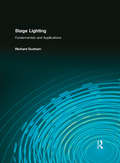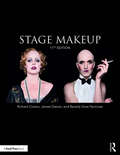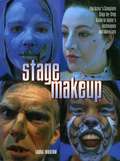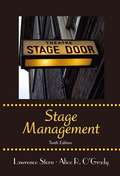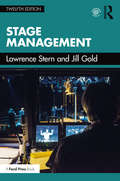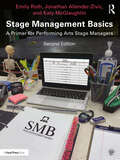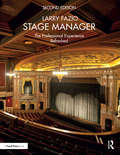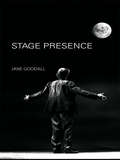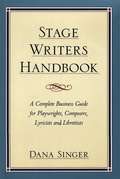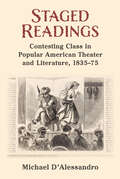- Table View
- List View
Stage Lighting: Fundamentals and Applications
by Richard E. DunhamThe book’s organization follows a layered approach that builds on basic principles: Light as a Medium (Part 1), Tools of a Lighting Designer (Part 2), Design Fundamentals (Part 3), and Lighting Applications (Part 4). This presents students with a practical and logical sequence when learning basic concepts. The full spectrum of the lighting design process is presented in detail, giving students an example of how one might develop a lighting design from script analysis through concept and plot development, and all the way to an opening. This detailed process with a step-by-step design approach gives students a plan to work from, which they can later modify as they mature and gain confidence as designers. The text contains a more comprehensive discussion of basic technology, light as a physical phenomena, and methodology of designs than is found in most introductory texts, bridging the gap between introductory and advanced lighting courses. The text will appeal to theatrical designers who want to venture into areas of lighting like architectural or virtual lighting design, while at the same time gaining a solid grounding in the fundmentals of lighting design. Lighting Design will also benefit illuminating engineers who want to move away from mere computational approaches in lighting and on to explore techniques along the design approaches of theatrical lighting design. The final 9 chapters cover many specialty areas of lighting design, highlighting the unique and shared qualities that exist between the different aspects of these elements. Discussions involve traditional entertainment areas like theatre, as well as lesser known facets of the industry including film/video, landscape lighting, retail/museum lighting, virtual lighting, concert, spectacle performances, and architectural lighting. Models of design tasks demonstrate the actual use and development of plots/sections, schedules, photometrics tables, and cut sheets, rather than simply talking about what they are. This hands-on approach provides students with a firm understanding of how to actually use these tools and processes.
Stage Makeup
by Richard Corson James Glavan Beverly Gore NorcrossWidely referred to as the “bible of stage makeup,” the timely revision of this classic text addresses principles and techniques in the use of makeup for the contemporary performer. This extensive exploration of the application and use of stage makeup and makeup for a variety of performance venues covers all aspects in detail and contains over 400 photographs, drawings, and diagrams demonstrating step-by-step procedures. Thoroughly updated and revised, this classic text remains accurate and comprehensive, providing information from which all readers – whether students to the field or seasoned, professional makeup artists – will benefit. New to this edition: Updated photography throughout. Features the latest information on products and techniques throughout. New additions to chapters concerning hairpieces and wigs: making a pattern for a beard and mustache, making a pattern for a wig, fronting a wig, or sending accurate information for rentals, and the basic roller set for wigs. The source Appendix has been totally updated with new vendors and the latest website addresses. The materials Appendix has had the most current products added. There are new, blank makeup charts for class work and designing makeups. There is a color guide for a two-part silicone life cast. The new color section featuring Academy Award nominee, Christien Tinsley, steps for the Tinsley Transfers for cuts, bruises and prosthetics. (As seen in the movie The Passion Of The Christ.) A selection of makeup in color with complete instructions. Color photos of Academy Award winner, Matthew Mungle, special effects makeup for the CSI television show. Instructions for a new “creating a likeness” of Queen Elizabeth I. The Film and Television chapter now includes information about working with the latest HD digital technology. The color section now includes a series of photos illustrating the effects of gel colors on natural makeup.
Stage Makeup: Special Edition
by Richard Corson James Glavan Beverly Gore NorcrossWidely referred to as the "bible of stage makeup," the timely revision of this classic text addresses principles and techniques in the use of makeup for the contemporary performer. This extensive exploration of the application and use of stage makeup and makeup for a variety of performance venues covers all aspects in detail and contains over 1000 photographs, drawings, and diagrams demonstrating step-by-step procedures. Thoroughly updated and revised, this classic text remains accurate and comprehensive, providing information from which all readers – whether students new to the field or seasoned, professional makeup artists – will benefit. New to this edition: Updated full-color photography throughout Expanded information on makeup design and application 48 new step-by-step instructions in color Expanded chapter on modeling with highlights and shadows New chapter on cross-gender makeup New instruction on making dentures, noses, and face casting New instructions for creating zombies, animals, aging effects, and trauma Expanded information on makeup for television and film Up-to-date information on Special Effects makeup Up-to-date information on prosthetic makeup Updated chapters on facial hair and wigs Updated resources for products, advanced training, and health and safety
Stage Makeup: The Actor's Complete Step-by-Step Guide to Today's Techniques and Materials
by Laura ThudiumThis up-to-date, full-color makeup manual is designed to lie open on the makeup table as a guide for student, amateur, or professional performers.
Stage Management
by Alice R. O'Grady Lawrence SternRevered as the authoritative resource for stage management, this text offers students a practical manual on how to stage manage in all theater environments. Rich with practical resources -- checklists, diagrams, examples, forms and step-by-step directions -- Stage Management eschews excessive discussion of philosophy and gets right to the essential materials and processes of putting on a production. In addition to sharing his own expertise, Stern has gathered practical advice from working stage managers of Broadway, off-Broadway, touring companies, regional, community, and 99-seat Equity waiver theaters.
Stage Management
by Lawrence Stern Jill GoldStage Management offers readers a practical manual on how to stage manage in all theatre environments. Revered as the authoritative resource for stage management, this text is rich with practical resources, including checklists, diagrams, examples, forms and step-by-step directions. In addition to sharing his own expertise, Stern has gathered practical advice from working stage managers of Broadway, off-Broadway, touring companies, regional, community, and 99-seat Equity waiver theaters. In its 11th edition, the book is now fully in color and updated to include new information on Equity contracts, social media applications in stage management, and working with high school productions.
Stage Management
by Lawrence Stern Jill GoldNow in its twelfth edition, Stage Management is the comprehensive go-to manual on stage management in all theatre environments. Revered as the authoritative resource for stage management, this text is rich with practical resources, including checklists, diagrams, examples, forms, and step-by-step directions. In addition to sharing their own expertise, Stern and Gold have gathered practical advice from working stage managers of Broadway, off-Broadway, touring companies, regional, community, and 99-seat Equity waiver theatres. This new edition has been fully updated with new technology and best practices, including: New websites for stage management tools and software Updated Equity rules Additional safety and emergency protocols New voices from practicing stage managers in text boxes and case studies scattered throughout the book. This practical guide is written for students of Stage Management in Theatre programs, as well as early career stage managers. The companion website features paperwork templates, downloadable checklists, suggested readings, a list of websites and apps with today’s cutting-edge stage management technology, and a list of over 500 internships and apprenticeships available across the United States.
Stage Management Basics: A Primer for Performing Arts Stage Managers
by Emily Roth Jonathan Allender-Zivic Katy McGlaughlinWithout assuming any intrinsic prior knowledge of the theatrical field and its associated, specialized terminology, Stage Management Basics covers every aspect of the stage management, from reading a script, meeting with a director and theatre staff, and auditioning, to constructing green digital scripts, communication best practices, and opening night protocol. Additionally, this book features multiple appendices containing stage management form templates, blank version of which are available on its companion website. This book touches on basic principles for stage management for theatre, dance, and opera productions.
Stage Management Basics: A Primer for Performing Arts Stage Managers
by Emily Roth Jonathan Allender-Zivic Katy McGlaughlinStage Management Basics, second edition, offers a deep dive into the basics of stage management for theatre, dance, and opera productions. Without assuming any intrinsic prior knowledge of the theatrical field and its associated, specialized terminology, this book covers every aspect of stage management, from reading a script, meeting with a director and theatre staff, and running auditions to communication best practices and opening night protocol. This new edition features brand new chapters on opera, dance, and unions, information on working with intimacy and fight directors, updated tips and tricks, and vibrant color images. Using simple language and detailed explanations, this book is the perfect primer for the beginning stage management student. The companion website contains blank form templates, chapter comprehension tests, a suggested reading list, glossary flashcards, and more.
Stage Management Theory as a Guide to Practice: Cultivating a Creative Approach
by Narda E. Alcorn Lisa PorterStage Management Theory as a Guide to Practice offers theory and methodology for developing a unique stage management style, preparing stage managers to develop an adaptive approach for the vast and varied scope of the production process, forge their own path, and respond to the present moment with care and creativity. This book provides tactile adaptive strategies, enabling stage managers to navigate diverse populations, venues, and projects. Experiential stories based on extensive experience with world-renowned artists exemplify the practices and provide frameworks for self-reflection, synthesis, and engagement with theory-guided practice. This book empowers stage managers to include the ‘How You’ with ‘How To’ by flexing collaborative muscles and engaging tools to guide any collaborative project to fruition with creativity, curiosity, and the drive to build connections. Exploring topics such as group dynamics, ethics, culture, conflict resolution, and strategic communication, Stage Management Theory as a Guide to Practice: Cultivating a Creative Approach is an essential tool for advanced stage management students, educators, and professionals.
Stage Management Theory as a Guide to Practice: Cultivating a Creative Approach
by Narda E. Alcorn Lisa PorterStage Management Theory as a Guide to Practice, Second Edition offers theory and methodology for developing a unique and inclusive stage management style, preparing stage managers to develop an adaptive approach for the vast and varied scope of the production process, forge their own path, and respond to the present moment with care and creativity. This book provides tactile strategies, enabling stage managers to navigate different groups of collaborators, venues, and projects. Experiential stories based on extensive experience with world-renowned artists exemplify the practices and provide frameworks for self-reflection, synthesis, and engagement with theory-guided practice. This book empowers stage managers to guide any collaborative project to fruition by incorporating the "How You" with the "How To." This second edition has been expanded, and includes new experiential stories and a new chapter focused on inclusive processes that can be applied from pre-production through closing, as well as the full text of the HowlRound Theatre essay We Commit to Anti-Racist Stage Management Education. Exploring topics such as group dynamics, ethics, culture, and strategic communication, Stage Management Theory as a Guide to Practice is an essential tool for advanced stage management students, educators, and professionals.
Stage Management: A Gentle Art (Stage And Costume Ser.)
by Daniel BondThis popular book describes in detail a stage manager's job. It provides those just starting out in the profession with a solid grounding in theatre stage management practices and procedures. The disciplines of lighting, set design and sound are discussed but the main focus is the management of these elements and the processes and scheduling that go together to provide effective results. Chronologically following the production of a play, the book starts with pre-production planning and progresses to opening night. With easy reference checklists and a full glossary, it is the essential guide to stage management.
Stage Manager: The Professional Experience—Refreshed
by Larry FazioStage Manager: The Professional Experience–Refreshed takes the reader on a journey through all aspects of the craft of stage management in theatre, including the technological advancements that have come to theatre and the stage manger’s job. Chapters are laid out to reflect the order in which stage managers experience and perform their work: what makes a good stage manager, seeking the job, building a resume, interviewing for the job, and getting the job (or not getting the job). Included are chapters on the chain of command, working relationships, tool and supplies, creating charts, plots, plans and lists, the rehearsal period, creating the prompt book, calling cues, and the run of the show. These are just some of the many topics covered in this book. In addition, the author uses interviews with stage management professionals in various stages of production, providing another view of how the stage manager is perceived and what is expected form the work of the stage manager. Fifteen years after the original publication of Stage Manager: The Professional Experience, this new and refreshed edition is now in color to help clarify and illustrate points in the text. It is fully updated to reflect the the world of computerized technology: smart phones, thinly designed laptops, tablets, use of email and text messaging, storing and sharing files and information in cloud-based apps. Then there are the innovations of automation–electronically moving scenery, scenic projections–casting images and patterns on the stage; moving lights; LED luminaires; lasers; and greater use of fog and haze machines. In addition, the extensive glossary of more than 600 terms and phrases had been extend to well over 700, providing and excellent professional vocabulary for anyone hoping to be a theatre stage manager or already working in the field.
Stage Presence
by Jane GoodallFocusing on examples of live performance in drama, dance, opera and light entertainment, Jane Goodall explores a characteristic as compelling and enigmatic as the performers who demonstrate it. The mysterious quality of ‘presence’ in a performer has strong resonances with the uncanny. It is associated with primal, animal qualities in human individuals, but also has connotations of divinity and the supernatural, relating to figures of evil as well as heroism. Stage Presence traces these themes through theatrical history. This fascinating study also explores the blend of science and spirituality that accompanies the appreciation of human power. Performers display a magnetism of their audiences; they electrify them, exhibit mesmeric command, and develop chemistry in their communication. Case studies include: Josephine Baker, Sarah Bernhardt, Thomas Betterton, David Bowie, Maria Callas, Bob Dylan, David Garrick, Barry Humphries, Henry Irving, Vaslav Nijinsky and Paul Robeson.
Stage Writers Handbook
by Dana SingerDana Singer, Associate Director of America's foremost playwrights' association, the Dramatists Guild, gathers all the information and ideas stage writers need to conduct their careers in a businesslike manner, with all the protections the law provides. Includes chapters devoted to copyright, self-promotion, representation, production contracts, publishing and licensing agreements, underlying rights and collaboration.
Stage and Picture in the English Renaissance: The Mirror up to Nature
by John H. AstingtonThis book presents a new approach to the relationship between traditional pictorial arts and the theatre in Renaissance England. Demonstrating the range of visual culture in evidence from the mid-sixteenth to mid-seventeenth century, from the grandeur of court murals to the cheap amusement of woodcut prints, John H. Astington shows how English drama drew heavily on this imagery to stimulate the imagination of the audience. He analyses the intersection of the theatrical and the visual through such topics as Shakespeare's Roman plays and the contemporary interest in Roman architecture and sculpture; the central myth of Troy and its widely recognised iconography; scriptural drama and biblical illustration; and the emblem of the theatre itself. The book demonstrates how the art that surrounded Shakespeare and his contemporaries had a profound influence on the ways in which theatre was produced and received.
Stage-Play and Screen-Play: The intermediality of theatre and cinema
by Michael InghamDialogue between film and theatre studies is frequently hampered by the lack of a shared vocabulary. Stage-Play and Screen-Play sets out to remedy this, mapping out an intermedial space in which both film and theatre might be examined. Each chapter’s evaluation of the processes and products of stage-to-screen and screen-to-stage transfer is grounded in relevant, applied contexts. Michael Ingham draws upon the growing field of adaptation studies to present case studies ranging from Martin McDonagh’s The Cripple of Inishmaan and RSC Live’s simulcast of Richard II to F.W. Murnau’s silent Tartüff, Peter Bogdanovich’s film adaptation of Michael Frayn’s Noises Off, and Akiro Kurosawa’s Ran, highlighting the multiple interfaces between media. Offering a fresh insight into the ways in which film and theatre communicate dramatic performances, this volume is a must-read for students and scholars of stage and screen.
Stagecraft Fundamentals
by Rita Kogler CarverStagecraft Fundamentals Second Edition tackles every aspect of theatre production with Emmy Award-winning author Rita Kogler Carver's signature witty and engaging voice. The history of stagecraft, safety precautions, lighting, costumes, scenery, career planning tips, and more are discussed, illustrated by beautiful color examples that display step-by-step procedures and the finished product. This second edition offers even more in-demand information on stage management, drawing and drafting (both by hand and CAD), lighting fixtures, and special effects. Also new to this edition are current articles from Lighting and Sound America, brand new diagrams that illustrate hard-to-grasp concepts, and a plethora of information on European conversions, standards, and practices, making the skills you learn applicable to stage jobs on either side of the ocean! The accompanying website, www.stagecraftfundamentals.com is bursting with additional material such as an instructor's manual, exercises and study questions that coincide with chapters from the book, CAD drawings, color theory, manufacturing information, and so much more to help you along the way as you learn all about the world of theatre production! Praise for the Book:Beautifully written! The author has succeeded in relaying technical theatre information without being too technical and putting the reader to sleep. I read three sentences and instantly knew this book was for me and the way I teach. When I think back on the insufferable intro to tech theatre books I had to read, I feel cheated I didn't have this one as a student. I will be using this text in my class! -- Rob Napoli, Designer and Technical Director at Penn State University, Berks Campus This text has temped me to return to teaching with a textbook for the first time in seven years. The language is both accessible and informal yet the text goes a long way in debunking some of the typical jargon that may alienate students just getting into the field, or trying it out for the first time. The illustrations (the text is full of them) coupled with the stories reinforce the fundamental information being conveyed. -- John Paul Devlin, Associate Professor of Theatre at Saint Michael's College What a great idea! Thank heavens someone is doing this for students at that impressionable age. That has been one of my mantras - education of teachers and students on the use of scenic materials. The teachers don't have enough time in college to learn and do everything they have to teach. Most get thrown into the theatre area by default and struggle with designing/building/painting the scenery. -- Jenny Knott, Rosco Stagecraft Fundamentals is beautifully illustrated throughout, and the pofusion of color on every page gives this textbook the appearance of a coffee table book. The writing is clear and personal, which should be very appealing to students. Rita Carver covers all aspects of theatre production from scenery, to lighting, to an actor's makeup. Her close ties to the New York theatre scene gives this book a special insight into the professional world, one that goes well beyond what is found in most college textbooks. -- John Holloway, Professor in the Theatre Department at the University of Kentucky and President of the International Association of Theatrical stage Employees (IATSE) Local 346. I can't thank you enough for Stagecraft Fundamentals. I have been teaching stagecraft since 1976 and you have saved me from the nightmare of writing a text to suit my class needs..After two semesters with your text, I have found that I had more time to develop the skills necessary within the classroom than before. The humor that you have infused in the book has enticed my students to read on. That alone makes this text invaluable.--Meta Lasch, Assistant Professor, West Liberty University
Stagecraft Fundamentals: A Guide and Reference for Theatrical Production
by Rita Kogler CarverStagecraft Fundamentals tackles every aspect of basic theatre production with Rita Kogler Carver’s signature wit and engaging voice. The history of stagecraft, safety precautions, lighting, costumes, scenery, career planning tips, and more are discussed, illustrated by beautiful color examples that both display step-by-step procedures and break with the traditionally boring black and white introductory theatre book. This third edition improves upon the last, featuring three new chapters on design for props, projection, and touring. Also included are new end-of-chapter questions and an expanded discussion on LED lighting, stage automation, digital technology, stage management, makeup, theatre management, and sound design. This is the must have introductory theatre production book.
Stagecraft Fundamentals: A Guide and Reference for Theatrical Production
by Rita Kogler CarverStagecraft Fundamentals, Fourth Edition, is an entry-level how-to guide and reference on backstage theatre, covering every aspect of basic theatre production. The history of stagecraft, safety precautions, lighting, costumes, scenery, special effects, career planning tips, and more are discussed, illustrated by beautiful full-color images that display step-by-step procedures. This fourth edition improves upon the last, featuring a new chapter on Costume Crafts, which includes information on millinery, shoes, fabric dyeing, fabric modification, distressing, masks, armor, body padding, and accessories. Also included is an expanded discussion on sound, props, rigging, safety, production management, and projection design, new information on digital theatre, new end of chapter exercises, additional information on US/UK standards, and an emphasis on diversity and inclusion. Each chapter features exercises, discussion questions, and study words to help the teacher and student review the content before moving on to the next topic. Stagecraft Fundamentals, Fourth Edition, is the must-have introductory theatre production book for Stagecraft, Technical Theatre, and Theatre Production courses. A companion website (www.StagecraftFundamentals.com) features additional articles and information, downloadable images and paperwork, chapter quizzes, and an instructor’s manual.
Stagecraft Fundamentals: A Guide and Reference for Theatrical Production
by Rita Kogler CarverStagecraft Fundamentals, Fourth Edition, is an entry-level how-to guide and reference on backstage theatre, covering every aspect of basic theatre production.The history of stagecraft, safety precautions, lighting, costumes, scenery, special effects, career planning tips, and more are discussed, illustrated by beautiful full-color images that display step-by-step procedures. This fourth edition improves upon the last, featuring a new chapter on Costume Crafts, which includes information on millinery, shoes, fabric dyeing, fabric modification, distressing, masks, armor, body padding, and accessories. Also included is an expanded discussion on sound, props, rigging, safety, production management, and projection design, new information on digital theatre, new end of chapter exercises, additional information on US/UK standards, and an emphasis on diversity and inclusion. Each chapter features exercises, discussion questions, and study words to help the teacher and student review the content before moving on to the next topic.Stagecraft Fundamentals, Fourth Edition, is the must-have introductory theatre production book for Stagecraft, Technical Theatre, and Theatre Production courses.A companion website (www.StagecraftFundamentals.com) features additional articles and information, downloadable images and paperwork, chapter quizzes, and an instructor’s manual.
Stagecraft in Euripides (Routledge Revivals)
by Michael HalleranIn Stagecraft in Euripides, first published in 1985, Professor Michael Halleran examines certain aspects of the dramaturgy of the most extensively preserved Attic tragedian. Although the ancient dramatic texts do not contain performance directions, they do imply stage actions. This work explores the ways Euripides utilises the latter to make a point: to underline some issue, to suggest a contrast, or to shift the focus of the drama. Specifically, Halleran investigates the rearrangement of characters on stage at the major structural junctures of the play: entrances and their announcements; preparation for and surprise in entrances; and dramatic connections between exits and entrances. Three plays from the same era – Herakles, Trojan Women and Ion – are discussed in greater detail to reveal the potential of this approach for illuminating Euripides’ ‘grammar of dramatic technique’. Stagecraft in Euripides will thus appeal to students of theatre and drama as well as classicists.
Staged Normality in Shakespeare's England (Palgrave Shakespeare Studies)
by Rory Loughnane Edel SempleThis book looks at the staging and performance of normality in early modern drama. Analysing conventions and rules, habitual practices, common things and objects, and mundane sights and experiences, this volume foregrounds a staged normality that has been heretofore unseen, ignored, or taken for granted. It draws together leading and emerging scholars of early modern theatre and culture to debate the meaning of normality in an early modern context and to discuss how it might transfer to the stage. In doing so, these original critical essays unsettle and challenge scholarly assumptions about how normality is represented in the performance space. The volume, which responds to studies of the everyday and the material turn in cultural history, as well as to broader philosophical engagements with the idea of normality and its opposites, brings to light the essential role that normality plays in the composition and performance of early modern drama.
Staged Readings: Contesting Class in Popular American Theater and Literature, 1835-75
by Michael D'AlessandroStaged Readings studies the social consequences of 19th-century America’s two most prevalent leisure forms: theater and popular literature. In the midst of watershed historical developments—including numerous waves of immigration, two financial Panics, increasing wealth disparities, and the Civil War—American theater and literature were developing at unprecedented rates. Playhouses became crowded with new spectators, best-selling novels flew off the shelves, and, all the while, distinct social classes began to emerge. While the middle and upper classes were espousing conservative literary tastes and attending family matinees and operas, laborers were reading dime novels and watching downtown spectacle melodramas like Nymphs of the Red Sea and The Pirate’s Signal or, The Bridge of Death!!! As audiences traveled from the reading parlor to the playhouse (and back again), they accumulated a vital sense of social place in the new nation. In other words, culture made class in 19th-century America. Based in the historical archive, Staged Readings presents a panoramic display of mid-century leisure and entertainment. It examines best-selling novels, such as Harriet Beecher Stowe’s Uncle Tom’s Cabin and George Lippard’s The Quaker City. But it also analyzes a series of sensational melodramas, parlor theatricals, doomsday speeches, tableaux vivant displays, curiosity museum exhibits, and fake volcano explosions. These oft-overlooked spectacles capitalized on consumers’ previous cultural encounters and directed their social identifications. The book will be particularly appealing to those interested in histories of popular theater, literature and reading, social class, and mass culture.
Staged Transgression In Shakespeare’s England
by Rory Loughnane Edel SempleStaged Transgression in Shakespeare's England is a groundbreaking collection of seventeen essays, drawing together leading and emerging scholars to discuss and challenge critical assumptions about the transgressive nature of the early modern English stage. These essays shed new light on issues of gender, race, sexuality, law and politics.
